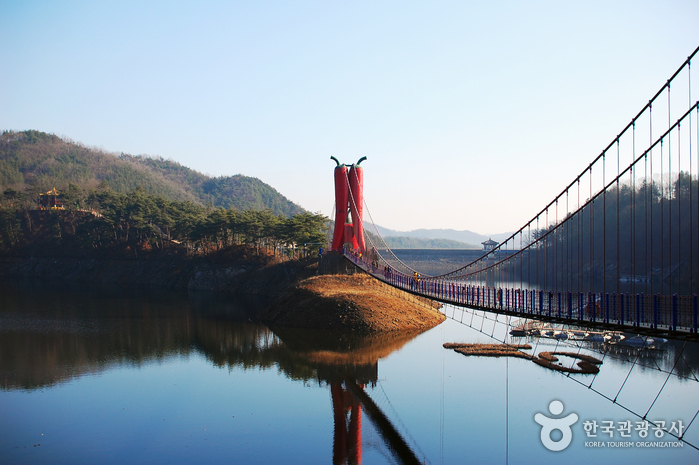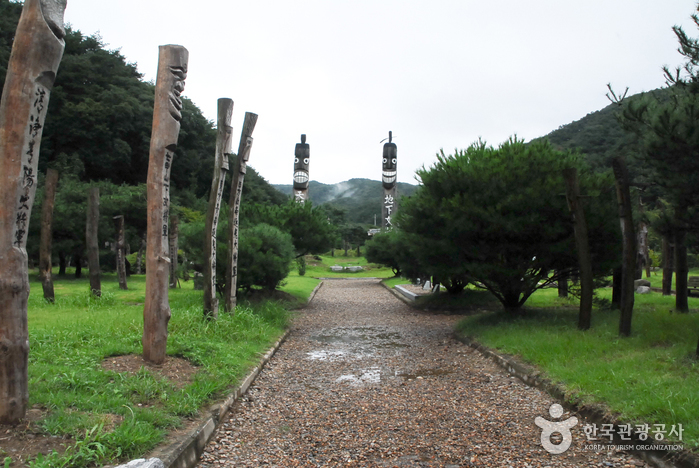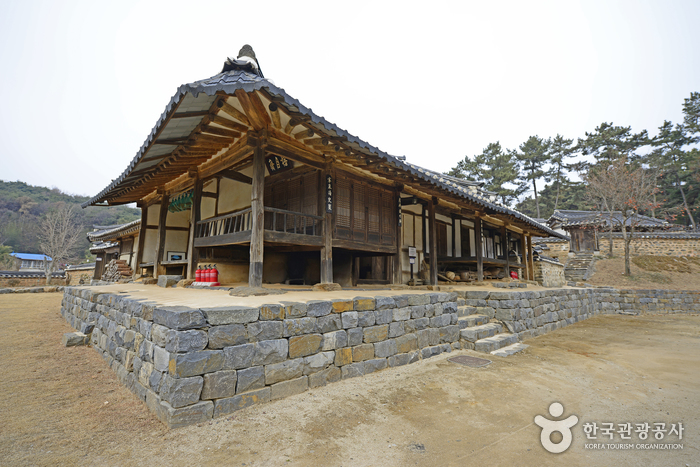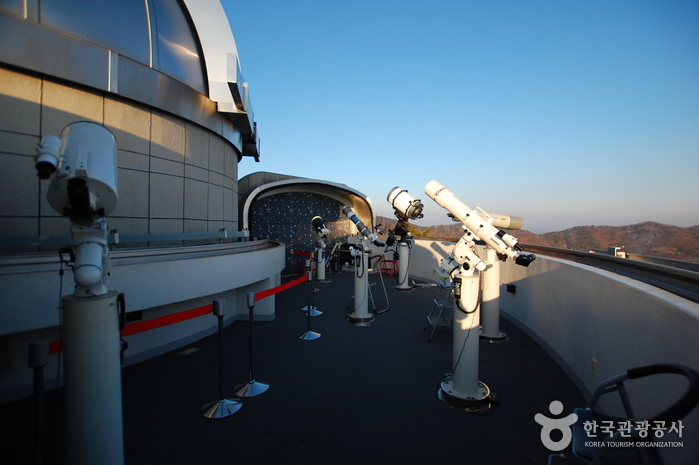Cheonjangho Suspension Bridge (천장호 출렁다리)
17.4Km 2024-02-23
24 Cheonjangho-gil, Jeongsan-myeon, Cheongyang-gun, Chungcheongnam-do
Built in 2009, this emblematic suspension bridge of Cheongyang stretches a total of 207 meters. Its most striking feature is a 16-meter-high main tower in the middle, ingeniously crafted to resemble Goji berries and red peppers, Cheongyang’s proud local produce. Below it is a narrow 1.5-meter-wide, 20-meter-long bridge, which starts to sway subtly both vertically and horizontally, offering a gentle thrill to whoever walks on it. This bridge is engineered to swing up to 30 to 40 centimeters, adding to the excitement of the crossing. Upon reaching the other side, visitors are greeted by an observatory and a trail leading up to Chilgapsan Mountain. For those who prefer a less strenuous journey, a leisurely stroll around Cheonjangho Lake towards Hwangnyongjeong Pavilion is a delightful alternative. The lake, overarched by the suspension bridge and nestled at the foot of Chilgapsan Mountain’s eastern reaches, presents a spectacular vista, rightfully counted among Cheongyang's most celebrated sights. The hiking trail ascends to the top of Chilgapsan Mountain, offering yet another perspective to appreciate the beauty of Cheonjangho Lake, the Cheonjangho Suspension Bridge, verdant forests, and charming valleys. An especially unique experience is visiting the Cheonjangho Suspension Bridge at night when it’s aglow, revealing a mesmerizing nocturnal allure.
Cheonjangho Lake (천장호)
17.5Km 2025-01-13
24-23, Cheonjangho-gil, Cheongyang-gun, Chungcheongnam-do
82-41-940-2723
Cheonjangho Lake is situated on the ridge of Chilgapsan Mountain about 11 kilometers away from the Chilgapsan Recreational Forest. This is reservoir of 1,200 hectares and is used to irrigate nearby farm land. Construction began in 1972 and took seven years to complete. The lake boasts clean water and an outstanding surrounding landscape. When it comes under fog or clouds, it creates a scenic view against the Chilgapsan Mountain landscape. In early spring, smelts are caught in abundance, drawing a growing number of tourists and anglers.
Baekje Cultural Museum (백제문화체험박물관)
18.4Km 2024-02-23
43-24 Janggok-gil, Daechi-myeon, Cheongyang-gun, Chungcheongnam-do
Designed to mimic the traditional kilns of the Baekje period, the Baekje Cultural Museum is a unique space that blends historical elegance with immersive exhibits. It showcases five key masterpieces: the historic Baekje kiln site that’s over 1,500 years old, exquisite blue tiles, an evocative painting of Choi Ik-hyeon's exile, an intricate rubbing of the Confucius statue, and a resplendent golden turtle. Additionally, the museum offers a variety of interactive centers like a gold mine exploration area, an agricultural culture center, an exhibition hall that transports viewers back to the 1960s. There are also Han Sang-don Memorial Hall, Yoo Sang-ok Donation Room, and Jeongseung Park. On weekends, the museum becomes even more lively, offering hands-on activities such as pottery and cup making, as well as the chance to dress in traditional Baekje attire.
Chilgapsan Jangseung Park (칠갑산 장승공원)
18.7Km 2021-08-18
Janggok-ri, Cheongyang-gun, Chungcheongnam-do
+82-41-940-2194
Jangseung Park on Chilgapsan Mountain is the largest preservation area for "jangseungs," the ancient wooden or stone totem poles that were usually placed at the village entrance to ward off evil spirits. It was established in May 1999 to counter the dwindling awareness of the artifacts, and houses some of Korea's tallest jangseungs (11.5 m) as well as replicas of indigenous totem poles from across the world. Today, it continues to host the Annual Chilgapsan Mountain Jangseung Festival, and serves as an important site of Korean history learning.
Baek il heon Head House (논산 백일헌 종택)
18.9Km 2024-08-05
45, Jugok-gil, Sangwol-myeon, Nonsan-si, Chungcheongnam-do
+82-41-736-4166 / +82-10-2911-4166
The Baegilheon Head House (National Folklore Cultural Heritage No. 273) is the house that was bestowed upon General Yi Sam by King Yeongjo in recognition of his achievement in suppressing the Yi In-jwa Rebellion in 1728. King Yeongjo also granted Yi Sam the posthumous name ‘Baegilheon’. The house is composed of the munganchae (gate quarters) situated next to a tall gate, the ‘ㄷ’-shaped anchae (women’s quarters), and the ‘ㄱ’-shaped sarangchae (men’s quarters), which are configured in an overall square layout. The accommodation includes the munganchae, the araet sarang with a numaru (upper floor), and the wit sarang and the geonneotbang, each of which has a large toenmaru (a narrow wooden porch running along the outside of the building). Notably, the geonneotbang, which is connected with the daecheong (wooden floor) and has a cozy courtyard surrounded by a mud wall, was the living space for the eldest son of the family and his wife for many generations. As the house has been designated as a National Folklore Cultural Heritage, cooking in the guestrooms is strictly prohibited. However, the house provides breakfast prepared by the daughter-in-law of the head house free of charge. The toilets and shower room are situated in the back yard.
Iksan Sungnimsa Temple (숭림사(익산))
19.8Km 2024-04-07
495-57, Baekje-ro, Iksan-si, Jeonbuk-do
+82-53-862-6394
Sungnimsa Temple is one of the major temples in Iksan under Geumsansa Temple and was believed by some to have been built by monk Jinpyo Yulsa during the reign of King Gyeongdeok (742-764) during the Silla period. Others believe that the temple was established during the first year of King Chungmok of the Goryeo dynasty in 1345. Sungnimsa Temple was named in honor of great monk Bodhi-Dharma, who practiced seated Zen meditation for nine years at Sorimsa Temple located deep inside Sungsan Mountain in China. The temple was burnt down during the Imjin War (1592-1598), leaving only Bogwangjeon Hall. Bits and pieces of the temple were later restored in 1697, 1819, and 1892.
Starpark (Chilgapsan Astrnomical Observatory) (칠갑산천문대 스타파크)
20.0Km 2024-02-23
178-46 Hantigogae-gil, Jeongsan-myeon, Cheongyang-gun, Chungcheongnam-do
Starpark, also known as Chilgapsan Astronomical Observatory, is nestled within Chilgapsan Provincial Park in Cheongyang-gun, Chungcheongnam-do. This observatory is a science museum with a focus on astronomy and space, catering to both the general public and students. Conveniently, it's just a five-minute walk from the parking area. The facility is housed in a three-story structure. On the first floor, visitors can enjoy a three-dimensional dome theater and an audiovisual room. The second floor houses a publicity center and an observation deck. The observatory’s main observation room is on the third floor and features Korea’s largest refracting telescope (APO 304 mm), which is used primarily for viewing sunspots and prominences during the day. Additionally, there’s an auxiliary observation room equipped with Korea's first 180-degree hemispherical three-stage sliding system. This room is designed for nighttime stargazing and is fitted with a 400-milimeter reflecting telescope for observing planets, star clusters, and nebulae. Children are particularly fond of the 12-meter geo-massive astronomical projection room, where they can experience 5D images. For those wishing to extend their visit, accommodations are available at Namcheon-ri Sanchon Ecological Village or nearby Alps Village. Staying in these locations provides easy access to both the Chilgapsan Astronomical Observatory and the Cheonjangho Suspension Bridge, making for a comprehensive educational and recreational experience.





 English
English
 한국어
한국어 日本語
日本語 中文(简体)
中文(简体) Deutsch
Deutsch Français
Français Español
Español Русский
Русский